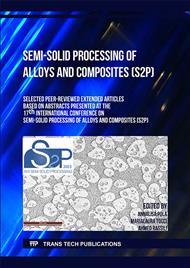p.21
p.27
p.33
p.39
p.47
p.55
p.61
p.69
p.75
A Study on Microstructure and Properties of Aluminum Alloy Bracket Produced by a New Semi-Solid Rheo-Diecasting Process
Abstract:
The performance of bracket component is low with uneven micro-structure, internal porosity and shrinkage defects produced by traditional liquid die casting process which cannot be strengthened by T6 heat treatment. In this paper, the aluminum alloy bracket with high-performance and light weight was prepared by a novel semi-solid slurry preparation technique that included chilling rod stirring and funnel-shaped cylinder device, which rapidly reducing the liquid temperature to near liquidus and realizing explosive nucleation. The effects of pouring temperature and CRS process on the microstructure and mechanical property of bracket were studied by optical microscopy (OM) equipped with polarizing mode and bench failure test. The results show that the as-cast microstructure mainly consists of near-spherical α-Al. And the semi-solid micro-structure was affected by these two critical parameters, the pouring temperature and CRS process. Without the condition of stirring, the micro-structure is typical dendritic with a certain proportion of fine spherical crystals, which was mainly generated during the filling of die casting process. And with the addition of the chilling rod, the finer and more uniform spherical semi-solid micro-structure was obtained with the lower pouring temperature. Based on the above semi-solid process and flow controlling through the mould design and vertical die casting process optimization, the high-performance bracket component without shrinkage can be prepared. Additionally, compared with the liquid die casting process, the internal quality and bench testing force of bracket prepared by CRS vertical die casting process are significantly improved.
Info:
Periodical:
Pages:
47-53
Citation:
Online since:
August 2023
Authors:
Price:
Сopyright:
© 2023 Trans Tech Publications Ltd. All Rights Reserved
Share:
Citation:



